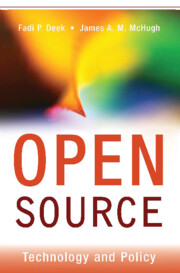Book contents
- Frontmatter
- Contents
- Preface
- Acknowledgments
- 1 Introduction
- Section One Open Source – Internet Applications, Platforms, and Technologies
- Section Two Social, Psychological, Legal, and Economic Aspects of Open Source
- 5 Demographics, Sociology, and Psychology of Open Source Development
- 6 Legal Issues in Open Source
- 7 The Economics of Open Source
- Section Three Free Software: The Movement, The Public Sector, and the Future
- Glossary
- Subject Index
- Author Index
- References
5 - Demographics, Sociology, and Psychology of Open Source Development
Published online by Cambridge University Press: 16 January 2010
- Frontmatter
- Contents
- Preface
- Acknowledgments
- 1 Introduction
- Section One Open Source – Internet Applications, Platforms, and Technologies
- Section Two Social, Psychological, Legal, and Economic Aspects of Open Source
- 5 Demographics, Sociology, and Psychology of Open Source Development
- 6 Legal Issues in Open Source
- 7 The Economics of Open Source
- Section Three Free Software: The Movement, The Public Sector, and the Future
- Glossary
- Subject Index
- Author Index
- References
Summary
Open source development is a form of distributed, collaborative, asynchronous, partly volunteer, software development. A new paradigm for cooperation like this invariably introduces new questions about its social characteristics and its affects on human behavior. Matters of interest range from the characteristics of the participants (demographic, motivational, etc.), the social psychology of their interactions, and the effectiveness of their cooperative processes, to the cognitive and problem-solving side effects of this kind of development. The purpose of this chapter is to survey these issues and identify some of the scientific and social concepts that can help in understanding them. We believe these social science perspectives can help provide a conceptual framework for better understanding open development. We will begin by considering the basic demographics of the phenomenon: the characteristics of the developer population, the motivations of developers and community participants, how participants interact, the diversity of projects, and so on. The survey by Kim (2003) is one of a number of useful surveys that have been done on these issues. We also examine relevant concepts from the field of social psychology, including the classic notions of norms and roles, factors that affect group interactions like compliance, internalization, identification and normative influence, the impact of power relationships and group cohesion, and the application of these concepts to open development. There are other useful abstractions available from cognitive science, such as the cognitive biases that affect group interactions and problem solving.
- Type
- Chapter
- Information
- Open SourceTechnology and Policy, pp. 159 - 221Publisher: Cambridge University PressPrint publication year: 2007

